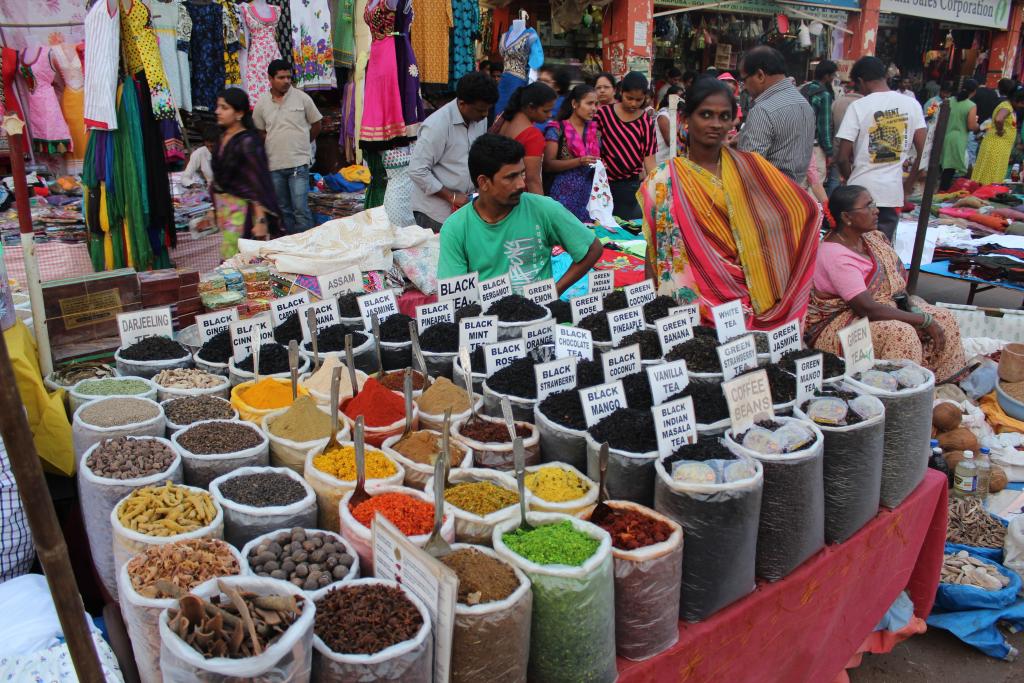
Over the summer, while browsing through the list of events that celebrate the International Year of Light 2015, I stumbled upon the description of a festival called “The Story of Light,” which sought to explore the intersection of science, culture, and philosophy through art and design. I submitted an application and was invited to participate as an intern for a four-week residency period prior to the festival from January 14–18 in Goa, India. In my next three posts, I will explore a series of impressions of Goa, the festival, and the amazing people I met.
Part 1: Impressions of Goa
Goa is abundance; abundance of people, cars, scooters, smoke, and dust, abundance of flavors, spices, and dishes on menus, abundance of smells from fennel and masala to sewer and cow dung, and abundance of religions and languages. My first impression of Panjim (the capital) is that of a spontaneous city that grew following the land around it; rather than shaping the landscape, Panjim adapts to it. Crooked streets and potholes line up along the river towards the ocean, like the tentacles of a massive jellyfish. The buildings are a mixture of colonial Portuguese architecture and new concrete living residences. The weather is benign during the winter months, with hot, sunny days and windy, chilly nights. Mosquitoes pervade the atmosphere at 6:00 pm every day to prickle the skin of unsuspecting tourists and even locals.
The coconut is the fruit of the land; street vendors cut green coconuts with unerring precision, using a curved blade that slices through the skin of the coconut with a dry thud (it’s impressive how these vendors still have all their fingers). Restaurants announce “veg” and “non-veg” food on their signs, and waiters sometimes insist on serving your food for you. People eat with their hands to experience the food with four of their senses; far from being a primitive practice, this requires some degree of skill and finesse to use only certain fingers and not drop the food all over yourself.
The Indian diet is high in fat and carbohydrates. Copious amounts of oil and butter are used to make thick, rich, gravy-filled dishes that are eaten with mounds of white rice or an assortment of flat breads (roti, naan, chapatti, etc.).Goan dishes often include fish, as the city is bounded by the Mandovi River and the Arabic Sea. Fish thali is the typical meal composed of rice or flatbread in a wide, circular metal plate with four or five smaller metal bowls inside. These bowls contain a variety of gravy-filled dishes with lentils, garbanzos, pickles, and assorted vegetables that are mixed with the rice or the bread.
Traffic is chaotic compared to what I had been used to in the US or in Panama. People drive on the left side of the road, just as in Great Britain. Motorcycles and scooters zoom around hastily trying to find any tiny gap between cars to advance a few seconds further on their commute. Honking is almost a rule on the streets to avoid being crushed by trucks or bumped into by a multitude of small cars trying to fit in a two-lane street. Road lines or lanes have little meaning, and vehicles swerve around constantly trying to get a few meters ahead. Shockingly though, it’s an ordered chaos. You don’t see them constantly crashing; there is some flow to this cacophony that you end up embracing when you’re driving. As long as you follow the flow, you will survive the traffic.

This abundance in all aspects of life in Goa made for an extremely rich cultural experience that shook me from head to toe and opened up new windows of thought in my 20-year-old view of the world. Moreover it increased my thirst for traveling to immerse myself in cultures radically different from my own; I hope to continue traveling and discovering in 2015.
In my next post, I will give impressions about the Story of Light Festival, an amazing gathering of scientists and artists from all over the world working together to showcase the importance of light using artistic installations, workshops, and performances. Stay tuned!

